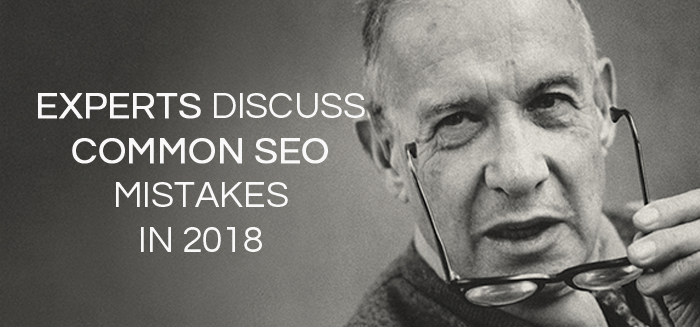Search engines continually shift and alter algorithms in order to identify the best results for Internet users. Due to this, search engine optimization must also change and evolve right along with it. Top performing websites in 2017 may fall with 2018 changes, even if the website doesn’t alter how it appears on search engines. Due to this, it is important to not only continually push to improve the website but to avoid potential pitfalls as well. Here are 10 common SEO mistakes to avoid in 2018.
1) Using High Competition Keywords
“Today it’s not about ‘get the traffic’ — it’s about ‘get the targeted and relevant traffic.” – Adam Audette, Chief Knowledge Officer, RKG
(Source)
When crafting a new blog post or anything else for the website, focusing on a selection of keywords is important. Whether from analytical data from what generates the most traffic to the page to attempt to expand a company footprint with new topics, keywords remain extremely important in 2018. However, far too many websites attempt to use high competitive keywords, which end up hindering its performance.
In the world of high-performance keywords, only the top, already known, websites perform well. If a website focuses on sporting events, writing a post with “basketball stats” as the keywords will not perform well. Larger and heavily trafficked sites like ESPN or CBS Sports crush the competition. A website needs to build itself off of more specific keywords. As traffic rates increase, the website can begin to use more highly competitive keywords in order to integrate into a larger, mainstream audience. However, until that happens, it is better to build a following and search engine results with extremely specific keywords.
The best way to go about ranking posts and websites well in search engines is to target lower performing keywords with less competition. This often sits in using descriptive phrases instead of singular words. As Higher Education Marketing (2018) points out, single word phrases are searched more, and cost significantly more to advertise than more descriptive, unique phrases.
2) Not Offering a Mobile Friendly Website
“SEO is all about user experience and presentation” – Ali Raza
(Source)
The desktop and laptop computers will likely remain an integrated part of technology. However, every year mobile Internet usage grows by leaps and bounds. Currently, more searches are performed through the aid of a mobile smartphone or tablet than are made with a traditional computer. Due to this, it is extremely important for a website to offer a mobile-friendly version.
Creating mobile-friendly variants of a website does require a fluid design. Fluid designed websites shift and alter visibility based on several different factors. Before the introduction of smartphones, website designers had very little to worry about in terms of display. Most computer screens were more or less the same size and only a handful of Internet browsers were available. Now, however, there are dozens of different mobile screen sizes, several operating systems and mobile Internet browsers, all while running on mobile operating platforms that may not all be up to date.
Desktop variations of websites do not always load properly on these devices. This leads to two problems. First, it requires a user on a mobile device to continually shift, zoom, scan and scroll through content. Second, and more important (at least in terms of search engine optimization), search engines such as Google rank websites with mobile-friendly versions higher than sites without mobile-friendly variants. In order to rank well in 2018 and avoid on-page SEO mistakes, it is vital to offer this mobile website version. According to BlazeDream (2017), 72 percent of smartphone users are more likely to revisit a website that performs well on smartphones. Additionally, 62 percent of companies with a mobile platform experience an increase in sales.
Having a mobile based website doesn’t just boost mobile SEO. It boosts website performance and sales figures.
3) Shorter Content
“Better content is outweighing more content.” – Rand Fishkin
(Source)
It’s no longer a matter of putting out content for readers and subscribers. The content must provide substantial value. There is a fine line here though of ranking well on search engines and providing readers with content that can be read in a few minutes. According to Snap Agency (2018), articles of 2,000 words rank the best in search engines. However, these articles do not always generate the highest bounce rate or bring back the greatest number of subscribers. Instead, it found posts that took around seven minutes to read scored the best with readers, which average out to around 1,000-word posts.
If the goal is to just hit the top of search engines, websites should focus on 2,000 words. However, if the goal is to maintain readership, boost subscribers and increase the rate of which readers return to the website, posts should sit between 1,000 and 2,000 words.
4) Backlinks Without Quality Content
“The best link building strategy is to create something awesome and let everyone know about it.” – Tim Soulo
(Source)
Backlinks have long offered websites with means of boosting SEO. Backlinks indicate another website has found the current site offers value, so it links to the page. Previously, search engines only looked at the number of backlinks. Now, however, the quality of the backlink matters. In order to prevent link stuffing, search engines such as Google not only require quality backlinks but also may actually reduce search engine rankings based on links without quality content.
According to MOZ, there are several ways to identify quality backlinks with strong search engine pull. Domain level links perform the best, followed by page-level links. What does this mean? These links share a relevancy to the website it sends traffic to. It doesn’t make sense for a kitchen repair service provider to link to a go-cart race track. The two have nothing in common and comes off as link stuffing (which may result in a search engine penalty). In order to avoid these on-page SEO mistakes, the link must be relevant. At the same time, broken links can both reduce the quality of backlinks while slowing down the website. Google provides a “Broken Link Checker” in its Google Chrome browser, which shows if the page is found and if there is a server response. It’s worth investigating to see where backlinks come from.
5) Failing to Optimize Pictures
“Good SEO is paying attention to all the details that most bloggers ignore.” – Ryan Biddulph
(Source)
Visuals play an important role in not only maintaining the interest of visitors to a website but boosting search engine performance. Unlike written text, pictures appear in visual searches. However, if the images are not optimized properly, the pictures will never appear in an Internet search.
When an image is captured, a camera tags a file name to it. This file name typically contains a long string of numbers and letters. If uploading this file name to a website, it’s what the file will be identified as (unless changed within the website editor). This is the equivalent of using nonsensical numbers and letters for a blog post title. In order for visuals to rank on search engines and boost overall website SEO, the pictures need to be optimized. This means adding in relatable image titles, as well as offering image tags when saving it to the website.
Additionally, according to Search Engine Journal (2017), much like written content, duplicate images do not rank well. So downloading stock photographs or using the same image over and over does nothing for SEO. So, while using stock photo services is fine for populating a website initially, it should really be used as a placeholder for original content.
6) Failure to Improve Load Time
“SEO is not about optimizing for search, it’s about optimizing for humans.” – Dharmesh Shah, Hubspot
Load time is more important now than it ever has been. Internet speeds continue to improve and with 5G mobile Internet connections around the corner, speed is everything. One of the biggest on-page SEO mistakes a website can make is failing to improve load time.
According to Practice Builders (2017), when a website takes four seconds to load, 25 percent of visitors will back out of the page. For a mobile page, 74 percent of visitors will abandon the site after five seconds. Plus, 46 percent of users do not return to a slow performing website. Additionally, for every one-second delay in load time, websites experience a 7 percent loss in conversions, 11 percent fewer page views and 16 percent decrease in customer satisfaction.
7) Keyword Stuffing
“My rule of thumb is build a site for a user not a spider.” – Dave Naylor
(Source)
Keyword stuffing stands as one of the biggest mistakes of website design today. While one of the more common SEO mistakes in 2017, in 2018 it will reduce a website’s ranking. The problem is, what is the best keyword density without falling under the wrath of Google and other search engines? There is a fine line between keyword stuffing and ideal density.
In general, Google has said time and time again keyword density no longer matters in 2018. With so many other ways to identify quality content, it’s not as important as in previous years. As Hobo Web (2017) points out, while there is merit to this, including keywords still informs search engines of the topic. And currently, two percent (or just under) ranks better than anything under one percent, and three percent risks potential stuffing penalties.
8) Not Auditing Your Website
“SEO is like a resume. You polish it so you have your best foot forward.” – Matt Cutts, Google.
(Source)
Website admins need to audit their website. This helps identify what’s not working on the site, ranging anywhere from keyword performance and image optimization to identifying bad backlinks, dead pages or areas of the site that are not loading quickly. According to W3Training School, one of the more common SEO mistakes in 2017 and now moving into 2018 is a failure to correct what hinders a site. It recommends performing a complex analysis of the website, including indexability, on-page/off-page rankings, its accessibility, website conversion, link building, internal links and so on. By looking over all of these website elements and correcting issues, the entire site will work faster, improve conversion rates and boost its SEO.
9) Using Article Spinning
“Write well throughout, thoroughly research, and topic focused content…” – Sue Bride

Mass publishing individual articles, whether for landing pages or to drive in traffic through other means use to offer admins a valuable method for boosting traffic without the need to handcraft dozens of different articles. However, search engines frown upon article spinning not only but it can result in search engine performance penalties as well. Article spinning falls under some of worst SEO mistakes of 2018 list because it comes across as inferior poor content and also duplicates content, each of which pushes a website’s search engine rankings down further. According to Time Rich Worry Free (2017), even the very best article spinning platforms leave nearly 40 percent of the new content the same. This means it’s necessary to go in and edit the additional 40 percent. The amount of time it takes to go in, have it spun, then edit and alter further is more than the time it takes to write a brand new post, all while potentially hindering the overall performance of the website.
Why does article spinning suffer from such poor results? Article spinning uses software to adjust words and phrases in order to maintain the same general flow and understanding while preventing the content from being flagged as “duplicate.” The main problem here though is most article spinners reproduce content with extreme grammatical errors. These kinds of articles not only read like the spun content but as the content offered is poor, search engines will rank it accordingly. There’s no point in using spun content if it only hurts website performance.
10) Failure to Update Your Website Frequently
“What gets measured gets improved.” – Peter Drucker

(Source)
Update frequency has become a major requirement for websites looking to perform well on search engines. In previous years, it took search engines like Google and Bing time to crawl websites and have the information catalog. Now, websites are crawled almost instantly. The more search engines visit a website in the form of scanning spiders, the better off it is. Due to this, failure to update a website frequently will result in search engines not visiting the site as often, which in turn will hinder its ability to rank well. Nearly every website at the top of search engine rankings is updated almost on a daily basis. Some of the worst SEO mistakes an admin can make is not updating the page.
According to HubSpot (and published by OffBeat Story), it’s best to publish multiple posts every day, at least when going strictly for SEO rankings. For most small businesses, posting this frequently isn’t a viable option. Posting 2-3 times a week only sees a slight performance drop off from posting daily. So, this is where the website and blog admins need to determine what works best for their time schedule. At a minimum, posting three or so times a week will generate the most user traffic, increase potential customer numbers while also boost SEO rankings.
In Conclusion
Search engine optimization will likely never it. The need to edit, alter and improve a website to better fit search engine algorithms remains essential for any website admin or owner. These are just 10 of the most common SEO mistakes to avoid in 2018. However, staying vigilant while monitoring analytical performance shifts is as important now as it ever has been.











